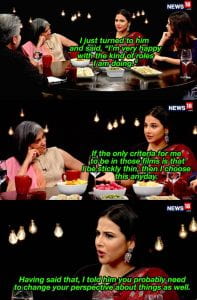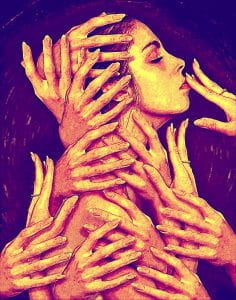“Hatred, dislike or mistrust of women, manifested in various forms such as physical intimidation and abuse, sexual harassment and rape, social shunning and ostracism, etc.”
(“Definition of Misogyny | Dictionary.Com”)
Underneath the Veil
Bollywood has always been a big affair. Extravagant musical performances, action-packed stunts, infusion of drama, and a three-hour story line, it is unlike any other. However, the veil of misogyny hidden for decades is just now being resurfaced. A decades long issue which became normalized and an “essence” of Bollywood, myriad aspects in films triggered misogyny through the forms of songs and dialogues. Influencing the audience, the structure of these films plays a negative role in the portrayal of women and has become one of the factors behind India’s high level of rape cases. Bollywood very poorly considers the modern era, instead dragging the same wrath of misogyny on and on. A shift in direction of recent movies has highlighted that Bollywood may be progressing slowly, but it still has a long way to go.
Unrooting the History
Misogyny has been rooted in Bollywood for decades. Was it always this way? The simple answer is no. Beginning with the early 1950’s era, films cast a very different approach in terms of women. This was deemed as the golden era where movies focused mainly upon social justice after the recent freedom movement. Ironically, films in the 1950’s gave women the portrayal of being strong and many thrived as female leads. However, a shift in Bollywood in the 1960’s and 70’s changed the whole presentation of females in the industry. These women embodied the role of a “damsel in distress” and men took pride in being an “angry young man.” These roles set into stone, and with the arrival of the 90’s came the highlight of items songs where the objectification of women deepened. Girls were dressed in scantily clothing surrounded by men. These musical performances became a must in movies and are very much still incorporated today. The movie could be horrendous, but an item song could capture all the eyes and that is what filmmakers wanted. The storyline of films changed from the surface but kept its true misogynistic aspects. Myriad details reflected what a “good woman” should be like and she should love the man despite his wrongdoings. Actresses slowly became sidelined and no longer held the importance in a film, only being added to add to the “richness” of the movie and attract the male gaze. Equally as talented as their male co-stars, these females never received the same recognition. Movies were made with an idea of the male actor as the focal point and only recently have the contribution of females came into the limelight. Many filmmakers are understanding the notion of changing with the time, hence the recent releases casting female leads have been a big hit. Let alone female leads, Bollywood is slowly making a transition to create films based on the problems of women and how they should be normalized in the world today. Sadly, the audience outpour for these misogynistic films is a lot higher than those who show the freedom of a woman. It is as if a mentality has been set by many people that this is the norm and this needs to be changed.
“Angry Young Man”
The “angry young man” phrase refers to the role of on-screen actors in which they are the perfect saviors and lovers. However, with upholding the pride of this role, women suffered within their roles. The angry young man would fight off villains, be possessive, stalk, abuse, and save the “damsel in distress.” What did the woman gain? Her only role is to showcase a terrified woman whose soul purpose is to love the man no matter what he does and that without a man she would not be able to do anything. The pictures show that this phrase is still into circulation today. What started with Amitabh Bachan is now being penned with Shahid Kapoor’s movie, Kabir Singh. This recent film shows an angry, male alpha who can do anything he wants and also slaps the actress in the movie. However, the many people sided with that this how men are and should be and it is a woman’s duty to love her man.
Male vs. Female Representation within Movies
Myriad times with dialogues, a lot of adjectives used within to describe males is not exactly equaled with the ones used for females. The word graph below describes how compact storylines in movies limit women to only a certain level of adjectives. “Beautiful” is the most used word for females while “wealthy” is the most used for males. Other adjectives such as “strong” and “successful” characterize the male cast while the female cast survives on the same old “attractive” or “widowed.” This tells us just how diversified the storyline of Bollywood movies are. Not at all. The story may be different, but the message ends up being the same for the way women are represented.
The chart below emphasizes various Bollywood movies through which we can see the screen time given to men versus women. The blue represents males while the red represents females. Majority of the movies showcase men having more screen time and dialogues. This shows the under- representation of females and the movies they occupy. One circle stands out the most which is the iconic movie, Queen. This movie was a breakthrough of misogyny, highlighting the freedom and strength of a woman without a man.
The chart below emphasizes the emotions aspect. Males have much more freedom within their roles and the type of roles given to them offers a variety of emotions. However women are signified to specific emotions, mainly consisting of only being happy as this shows them being “pious” and “respectful.” The chart displays that the angry emotion is at an all time low for women across the span of years and being happy is the highest. For men both emotions are about equal. This accumulates the whole representation of women in general. With movies providing these outlooks, a wrong idea of how women “should be” is presented leading men to have a set mentality about women.
Actresses Speaking Out
Film critic, Rajeev Masand, invited various Bollywood actresses from three different generations to reflect upon the sexism and misogyny they faced within their time in the industry.
Swara Bhaskar was harassed when she was a young actress.
Many women in the industry can name horrific incidents that they have encountered just because they are women. These men feel as if they have the right to do anything they want.
Ratna Shah believes women that are a part of misogynistic films are to be blamed also.
Women empower one another. However myriad Bollywood movies show that actresses want to be part of misogynistic movies because just by working with a famous male actor or doing a hit item song can bounce them into the limelight. 
Vidya Balan mentions how her weight is constantly shown as an issue.
After gaining weight, many women are forced to lose the weight or ousted from the industry to not abide by the looks of being skinny. This leads to a career end for many females and the shaming on top of that is what they have to constantly endure. 
Swara Bhaskar mentions a terrible incident she encountered.
Zaira Wasim mentions how misogyny encompasses social media.
Once again the weight of a woman is what the focus is on rather than the talent they possess.
Vidya Balan embarks upon body-shaming.
Despite being one of the most versatile actress of her time, Vidya Balan’s weight at one point outshined her career. But she bounced back to show that her talent is what really matters.
Opposition
As much as Bollywood seems to be far away to adopting female led movies, there has been recent changes. From the iconic movie Queen to Neerja, women are slowly becoming a focal point. Other than just the cast itself, many scripts are being written to cast towards female problems relating to the world today. Although a male led movie, Padman, highlighted the notion of a serious problem of women in India embarking on the importance of using a pad. A husband goes through countless struggles to make a pad for his wife as the one sold in his village is too expensive and due to this many women end up using cloth. Veere Di Wedding, a comedy, focused on what a women wants and she too can break the boundaries of society. Casting a story of four strong women, this film showed what it truly is to be a woman from emotions to pleasure to making it known to society that girls are not here just for taking care of boys. Slowly, these movies are being adopted and it will take a while. Bollywood movies have cast a mentality and they are supposed to be “a certain way.” Breaking from this boundary will take ages, however this trend is being shattered with the changing generation.
Larger Significance
This is an important aspect to care about. Representation of women plays a large role in the world today where women have just begun to shine through. Looking at my personal background, I love to watch Bollywood movies. When I was younger, the repetitive storyline of movies set a fact in my mind that this is how Bollywood should be. However, with changing times and more knowledge on certain topics, I was able to see exactly how these movies affect in the long term and the message they spread in connection to women. There is always a damsel in distress or a weakness associated with actresses. Women have so much more to provide than just be a form of entertainment. Accomplished actresses who have gotten past this misogyny are changing the direction. But this acceptance of encouraging female-led movies, diminishes the concept of misogyny and emphasizes how important women are to cinema than just being for the “male gaze.” This starts with the people. The audience is the main culprit in encouraging this misogyny. Filmmakers will create what they know the audience wants to see. However if the audience changes their outlook then women in India can climb the ladder and be of equal level as men.
Works Cited
“Definition of Misogyny | Dictionary.Com.” Www.Dictionary.Com, 2021, www.dictionary.com/browse/misogyny.
Subramanian, Saranya. “A History of Bollywood: Item Numbers.” MirchiPlay, 31 July 2020, www.mirchiplay.com/films/legacy-of-bollywood-item-numbers.
Thomas, Sonia Mariam. “14 Confessions About Sexism And Misogyny In Bollywood From The 2017 Actresses Roundtable.” BuzzFeed, 29 Dec. 2017, www.buzzfeed.com/soniathomas/14-confessions-about-sexism-and-misogyny-in-bollywood-from.
Staff, Reuters. “Statistics on Rape in India and Some Well-Known Cases.” U.S., 6 Dec. 2019, www.reuters.com/article/us-india-rape-factbox/statistics-on-rape-in-india-and-some-well-known-cases-idUSKBN1YA0UV.
Shah, Priyanka. “The Bollywood Hero : How The ‘Angry Young Man’ Typically Reduced The Actresses To Puppets.” VoxSpace, 21 May 2018, www.voxspace.in/2018/05/10/angry-young-man-hero.
Vitamin Stree. “The Problem with Bollywood Today.” YouTube, 25 Dec. 2019, www.youtube.com/watch?v=CIdSmG-5Q5k.
“Bollywood’s Misogyny Problem Is Not New.” South Asian Post, 4 July 2019, p. 19. EBSCOhost, search.ebscohost.com/login.aspx?direct=true&AuthType=ip,shib&db=n5h&AN=137333368&site=eds-live&scope=site.
BuzzFeed India. “How Bollywood Normalised Rape Culture | BuzzFeed India.” YouTube, 8 Nov. 2019, www.youtube.com/watch?v=0mfgjLttbcA.
Arora, Anupama. “Nobody Puts Rani in a Corner: Making of the New Indian Woman in Queen (2014).” South Asian Popular Culture, vol. 17, no. 2, July 2019, pp. 145–157. EBSCOhost, doi:10.1080/14746689.2019.1613783.
“Behind the Making of a Monster.” India Today., North American special ed., Aroon Purie for Living Media India Ltd, pp. 31–31.
Manohar, Uttara, and Susan Kline. “Sexual Assault Portrayals in Hindi Cinema.” Sex Roles, vol. 71, no. 5–8, Oct. 2014, pp. 233–245. EBSCOhost, doi:10.1007/s11199-014-0404-6.
Manzar, Benazir, and Aju Aravind. “(Re) Thinking Women in Cinema: The Changing Narrative Structure in Bollywood.” South Asian Popular Culture, vol. 17, no. 1, Apr. 2019, pp. 1–13. EBSCOhost, doi:10.1080/14746689.2018.15
Wazir, Burhan. “Misogyny in Bollywood.” The World Today, vol. 69, no. 1, 2013, pp. 42–43. JSTOR, www.jstor.org/stable/41962918. Accessed 6 Apr. 2021.












